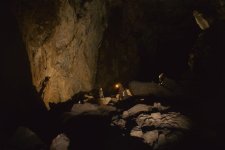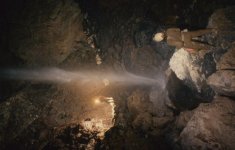As it turned out, the trip was sufficiently relentless that I didn't have time to post any updates here while we were away.
The expedition was (is) 3 week long. The first two weeks saw the most people up at Ario (up to about 25) and a smaller group remain this week.
Objective 1 was the leads in upstream C4 (see above). Close to the upstream limit a confluence is found. Up the right hand branch two climbs were left ongoing in the Sanctuary (a big chamber at the end) and up the left hand branch a third climb had been left. The area is intriguing since it’s not clear which branch is the main stream – they both appear to be very similar-sized passages and take a very similar quantity of water.
This year we quickly set up camp at Bugger Bognor (approx. -400 m; slightly higher than ideal, but a comfortable, dry camp site). The first camping trip took a few photos (that no doubt will appear here soon), rigged the final pitch that we hadn't got around to sorting last year, verified that the ropes on the pitch up to the Sanctuary were in good condition, and dropped some kit at the end.
The second camping trip (and the only pushing trip down C4 this year) saw four of us head in. One pair (Rich and Paulina) went to the Sanctuary leads up the right hand branch, and the other went up to the climb in the left hand branch. Jean-Luc and I comprised the latter team, and despite having camped for several nights in the Sanctuary in 2017 I’d never been up this left hand branch (presumptuously named the "F64 Inlet"). On arriving at the inlet climb (Bish Bash Bosch) we were somewhat underwhelmed: although there was some black space above, it looked a relatively minor inlet and had no perceptible draught (from the floor) or significant amount of water entering. Before starting the climb we decided to take a look at the previous upstream limit.
The waterfall in the final chamber just before the 2017 upstream limit (photo Duncan Simey)
Up the (largely brilliant) streamway we went, until we reached the climb by the waterfall in the final chamber. The ropes were fine, so we popped up these to find the stream emerging from a narrow rift. A common feature of Ario caves is a transition from wide, spacious passages to narrow impassable-looking rifts, but if you can find the right level and make progress through the narrow sections you are often rewarded with larger passage beyond. I had a clamber around in the rift, frustratingly close to fitting through, but just not quite managing to. Jean-Luc pointed out a possible widening fairly high in the rift, and a steady climb of about 12 m saw me at the dark space he’d seen. The chossy entry to the hole ahead clearly showed no-one had been before. Jean-Luc followed me up, and we found ourselves standing in a sizeable chamber. Following a sandy slope up, we soon reached a significant drop back down with a further possibility to traverse ahead. Interesting!
We’d left our kit back at the bolt climb, so needed to return to here to pick up SRT kits, bolting stuff and survey kit. After a crash-course in surveying and Disto use, we started the survey up through our new finds. Once at the drop I set to bolting, descending about 15 m to a ledge, and finding a further drop beyond. Surveying whilst bolting was a new combination for me, but it seemed to work just about OK. Down the next drop we were looking short of rope but luck was (just) on our side and despite having to unclip my descender crab to get off the rope, we found ourselves standing on boulders in the now spacious-again streamway. I quickly scrawled details for a final survey station, delighted that we had passed this obstacle, but aware that time was getting on and that the pair in the Sanctuary may well be finishing off their climbs. Jean-Luc asked me if I’d looked around the corner, which I hadn’t really in my haste to sort all the bolting kit and sort the final survey station. “It’s like Easegill Main Drain”, he said, looking along the passage ahead of him. We agreed to “just have a quick look” along the new section of streamway, and followed the delightfully sizeable passage around a few corners. Looking up, we realised we could now see a roof above – something that hadn’t been the case for a long time. Keen not to leave a “wide open” lead for someone else that proved to immediately sump, we figured we should see what happened further on now the roof was lowering. Sure enough, a few corners later saw the roof meet the water at a beautiful clear sump pool. We extended our survey, moved our final survey marker and returned. We were gutted not to have a camera with us, but our original objective of bolt-climbing had seemed unlikely to prove photogenic, so a camera hadn’t quite made the kit list. Anyhow, adding photography to bolting and surveying as a pair may have been an activity too many.
Leaving our new discoveries (“Look Around You”), we returned to the Sanctuary at about 10 pm to find that Rich and Paulina had just returned from their exploits on the climbs above (one got too small, one got too big!). Much out-of-date freeze-dried food followed before a steady trip back up to camp. Once there it was time for more brews, more noodles, then finally we were in our sleeping bags for about 4 am.
The following C4 trip saw the old Sanctuary camp dismantled and removed and the start of the derig. The next saw the section below Bugger Bognar derigged and camp packed away. Finally, in one very impressive effort, the last trip there saw the whole cave derigged from camp to the entrance. C4 had been rigged for way too long, so it’s great to finally have it ticked off, even if we had to tell Tony in the same sentence that we’d found a lovely looking sump and that the cave was being derigged…






